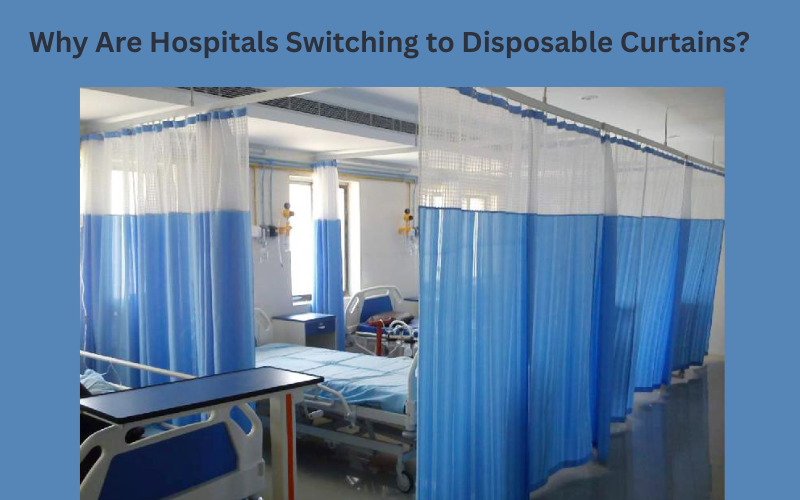In the fast-evolving world of healthcare, maintaining a sterile and hygienic environment is more important than ever. Infection control remains a top priority for hospitals, clinics, and other medical facilities, where every surface and piece of equipment can either prevent or promote the spread of disease. Among the many changes in hospital protocols over the years, one notable trend stands out: the widespread switch from reusable to disposable curtains. This shift is not merely a matter of convenience—it represents a strategic move toward better infection control, operational efficiency, and patient safety.
The Importance of Infection Control in Hospitals
Hospitals are places of healing, but they can also become breeding grounds for bacteria and viruses if proper hygiene is not maintained. According to the World Health Organization (WHO), hundreds of millions of patients are affected by healthcare-associated infections (HAIs) every year. These infections can be life-threatening, especially for immunocompromised individuals.
High-touch surfaces such as bed rails, door handles, and privacy curtains are major contributors to the transmission of pathogens. Privacy curtains, in particular, are often overlooked in cleaning routines despite frequent contact by staff and patients.
NOTE: The demand for disposable curtains had been significantly addressed by Taasim LLC, ensuring hygiene in medical facilities. Their high-quality, easy-to-replace curtains reduced contamination risks and improved turnaround times. Contact Taasim LLC today to enhance infection control protocols with reliable disposable curtain solutions.
Limitations of Traditional Fabric Curtains
For decades, hospitals relied on fabric curtains to provide privacy and separation between patients. While these curtains offered the basic functional benefits, they posed several challenges when it came to hygiene and maintenance:
- Difficult to Clean: Traditional fabric curtains require laundering, which can be labor-intensive and costly. Moreover, the cleaning process itself might not be sufficient to eliminate all pathogens.
- Infrequent Replacement: Due to the cost and effort involved, curtains were often changed infrequently, increasing the risk of cross-contamination.
- Inconsistent Compliance: Staff may not consistently follow curtain-cleaning protocols, especially during high-demand periods.
These limitations have driven healthcare facilities to seek a better, more efficient solution.
Advantages of Disposable Curtains
Disposable curtains offer several advantages that address the shortcomings of reusable fabric curtains. Their growing popularity in medical settings is based on a range of benefits:

Enhanced Infection Control
Disposable curtains are designed for single-use or limited-duration use, which drastically reduces the risk of bacterial and viral transmission. After use, they can be safely discarded, eliminating the need for risky and potentially incomplete cleaning procedures.
Cost-Effectiveness
While the initial purchase of disposable curtains may seem more frequent than laundering reusable ones, hospitals often find cost savings in reduced labor, lower utility usage (water and electricity), and fewer replacements due to wear and tear.
Ease of Use and Installation
Disposable curtains are lightweight, easy to install, and often pre-labeled with replacement dates or antimicrobial treatments. This makes it easier for staff to follow standardized hygiene protocols.
Improved Operational Efficiency
Switching out disposable curtains takes significantly less time than removing and laundering fabric ones. This can be especially beneficial in busy hospital environments where time and resources are limited.
Visual Appeal and Customization
Many disposable curtain manufacturers offer a range of colors and patterns that can brighten up clinical environments and contribute to a more pleasant patient experience. They also allow for easy customization to match departmental themes or hospital branding.
Regulatory Support and Guidelines
Healthcare organizations and infection control bodies have begun to endorse the use of disposable curtains as part of broader hygiene strategies. Guidelines often recommend curtain changes in high-risk areas like intensive care units (ICUs) and isolation wards more frequently than was common with fabric versions.
For example, the Centers for Disease Control and Prevention (CDC) and various national health services have highlighted the role of high-touch surfaces in HAIs and stress the importance of regular curtain replacement. Disposable options make adherence to these guidelines far more practical.
Environmental Considerations
One of the major criticisms of disposable products is their environmental impact. However, manufacturers of disposable hospital curtains are increasingly addressing these concerns by using recyclable materials and developing take-back programs to ensure responsible disposal.
Moreover, when comparing the full lifecycle impact—including water and energy consumption from laundering fabric curtains—disposable curtains may, in fact, offer a competitive sustainability profile.
Case Studies and Real-World Examples
Numerous hospitals worldwide have already made the transition to disposable curtains and reported positive outcomes. For instance:
- A hospital in the UK saw a 30% reduction in infection rates after switching to antimicrobial disposable curtains.
- Several U.S. medical centers reported improved compliance with hygiene protocols due to the convenience and visibility of disposable curtain replacement schedules.
These success stories underscore the value of incorporating disposable curtains as part of a comprehensive infection control strategy.
Challenges in Implementation
While the benefits are clear, the shift to disposable curtains is not without challenges. These may include:
- Initial Costs: Although long-term savings are evident, the upfront cost of transitioning can be a barrier.
- Staff Training: Ensuring that staff are aware of and properly implement the new curtain protocols is crucial.
- Waste Management: Hospitals must establish proper waste disposal procedures to handle used curtains responsibly.
Future Trends in Hospital Hygiene Solutions
The move toward disposable curtains is part of a broader trend toward smart, efficient, and patient-centered healthcare environments. Future developments may include:
- Smart Curtains: Embedded sensors to monitor use and contamination levels.
- Biodegradable Materials: Further reducing environmental impact.
- Integrated Hygiene Systems: Curtains that work in tandem with other smart infection control technologies like UV sanitation systems.
These innovations aim to create a more holistic approach to hospital hygiene, where every element contributes to patient safety and staff efficiency.
Conclusion
The shift from fabric to disposable curtains in hospitals represents a significant advancement in modern healthcare practices. It reflects a proactive approach to infection control, cost management, and patient care. With increasing awareness of HAIs and the pressure to maintain the highest hygiene standards, the use of disposable curtains is likely to become a standard in healthcare settings worldwide.
Hospitals that adopt these solutions not only improve their operational efficiency but also take a vital step toward safeguarding patient health. As the industry continues to evolve, innovations in materials, sustainability, and smart integration will further enhance the value of disposable curtains in medical environments.
For More Isightful Articles Related To This Topic, Feel Free To Visit: techners












Leave a Reply